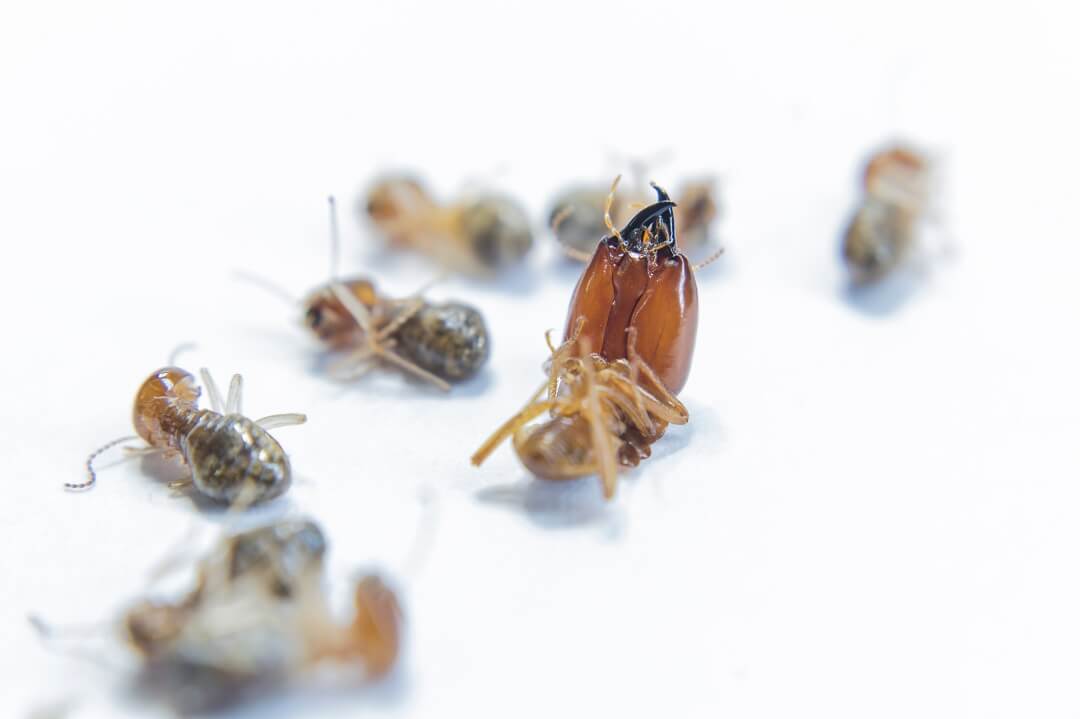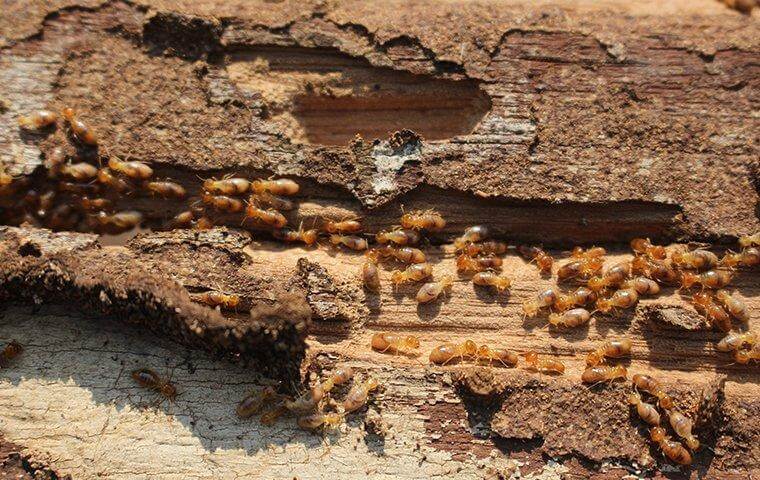Termites are responsible for over five billion dollars in damage every year in the United States and just about every property in California is at risk of termite damage. But how do you know if termites have invaded your home?
Here we identify many of the early signs of termites to be on the lookout for in order to help minimize the potential damage these pests can create. With early detection and professional termite control treatments, you can save yourself thousands of dollars in the potential home or business repair costs.
Key takeaways
- The main termite types found in Southern California are the subterranean and drywood termites.
- The presence of termites in your home or business can create a variety of signs to look for. While many of these signs can occur due to the presence of either species, mud tubes are exclusive to subterranean termites while piles of frass are an indication of drywood termites.
- An active termite colony can take as long as five years to become mature. However, a colony of 60,000 termites can eat a foot of a 2X4 beam in under five months! Finding early signs of a termite infestation allows you to call in termite control professionals before too much damage is done.
How do I know if I have termites?
The two main types of termites that can infect your home or business and cause major damage in Southern California are drywood termites and subterranean termites.
The most common, subterranean termites, live and nest within the soil underneath your home and, despite the fact that they create much larger nests, can be the more difficult of the two to identify when it comes to a home infestation. A key sign you have subterranean termites will be the presence of mud tubes, which we will explore below.
In contrast, drywood termites do all they can to avoid the soil and instead create their nests within drywood, or the structural lumber used in your home, deck, or fencing. The main sign of these termites is the presence of frass, which we will explain further below.
13 signs of termite infestation
As a resident or business owner in Southern California, you must always be aware of potential signs of a termite infestation. The fact is termites can take residence in your home or business long before signs or damage are visible, so waiting for signs to appear usually means you have an active infestation.
Because termites are so common in Southern California, it is recommended to have yearly termite inspections by professional pest and termite control companies to look for hidden signs and damage before it becomes a larger problem.
Here we take a look at some of the most common signs of termite activity.
1. Blistering or hollowed wood
Termites tend to feed on the wood within your home or business from the inside out, leaving behind hollowed areas underneath the surface. When you knock or tap on walls infested with termites, you are likely to hear a hollow sound. In severe cases, the wood may be completely gone, with only a layer of paint remaining. You may also see small, unexplained cracks in the wood or blistering or wood that looks similar to water damage.
2. Damage under paint or wallpaper
As termites feed or create nests in the wood of your home, they create tunnels underneath the surface of your walls. Oftentimes, these tunnels rest just underneath the layer of paint or wallpaper on your walls. Signs of these tunnels in the walls can include:
- Bubbling paint
- Discoloration of areas of the wallpaper
- Buckling, dented, or sunken areas of the walls where the paint or wallpaper is collapsing into the tunnels
- Small pinhole-size exit holes
3. Mud tubes
Subterranean termites create their nests in the soil around or underneath your home or business and build mud tubes as a way to travel from their nest to their food source, or the wood in your home or business. These mud tubes are made of a combination of soil, saliva, and termite droppings. They are most commonly found around and attached to the foundation of your home or business. These mud tubes provide a protected method of travel as well as provide moisture to the termites.
4. Swarmers
Swarmers are often the first sign of a termite infestation in your home. These flying termites are the members of the colony that leave the nest in order to mate and establish new colonies. Some swarmers will fly more at night, while others prefer the daytime. However, you can most often see swarmers after it rains. Once these swarmers find a mate, they shed their wings.
5. Discarded wings
Finding areas of discarded wings around your foundation or inside your home is another sign of a termite problem. These wings are discarded by the swarmers once they find a new mate.
6. Frass
A key sign of a drywood termite infestation is the presence of frass or termite droppings. While you may find this with subterranean termites as well, it is less common because they use frass to build mud tubes. Drywood termites push this frass through small holes in the wall as they do not want it in their nest. This creates small piles of frass along the edges of walls or windowsills that look similar to piles of sawdust.
7. Clicking sounds in the wall
If you notice a clicking sound coming from your walls, it can indicate that termites are within the wood. This clicking noise can be from either body shaking or chewing. Termites are very sensitive to noise and vibrations. When the colony is disturbed, soldier termites will shake their bodies or bang their heads against the wood in order to alert other members of the colony that there may be a danger. Worker termites, on the other hand, are busy munching away at the wood and cellulose in your home and they are not quiet about it. When workers are feeding, that clicking noise you hear may actually be chewing.
8. Termite holes
When drywood swarmers leave the nest, they typically leave through what are known as termite exit holes. Swarmers chew these small holes from the nest to the outside in order to exit and swarm in the search of a new mate. In most cases, these holes are filled in with frass by the remaining termites, but they may still be visible. They are, however, less than 1/8th of an inch and can be difficult to see unless you know what you are looking for. These are typically signs that termite control professionals look for.
9. Tight-fitting doors and/or windows
If you notice that you are having trouble opening windows or doors, it could be a sign that termites have moved in. When termites feed on wood, they produce moisture that can cause window frames and doorways to warp.
10. Live termites
Obviously, the appearance of a termite is a sign you may have a problem. But how do you identify a termite? Termites are similar in size and shape to small ants. The difference is that termites have a wider waist segment, straight antennas, and are white or translucent in color. While both termites and flying ants can have wings, ants have larger front wings while termite wings are both the same size.
11. Moldy scent
Termites give off an odor that smells similar to mold or mildew and is often mistaken for potential water damage. If you notice a musty smell that you can’t seem to pinpoint, it may be an underlying sign of a termite infestation within your walls.
12. Squeaky floors or loose tiles
Termites will feed on any wood products they can find, and this includes wood used in subflooring or in hardwood floors. If termites are feeding in your flooring, you may experience sagging or blistering in the flooring, as well as loose tiles that are no longer secured to the subflooring.
13. Flickering lights or loss of power
While termites are best known for eating wood and wood products, the fact is they will feed on anything that gets in their path and this includes power lines. If you are experiencing fluctuations in your power or flickering lights, termites may be to blame.
How long does it take for termites to cause damage?
Termite colonies take anywhere from three to five years to fully mature and, in many cases, three to eight years before signs of termite damage become visible. However, a colony consisting of 60,000 termites can eat one foot of a 2X4 beam in less than five months, meaning in a very short time a large termite colony can cause extensive damage that could cost you thousands of dollars.
Will termites go away on their own?
While most pests invade a home or business in search of a food source, termites enter your property because it IS their food source. As long as your home or business is still standing, they still have a food source, so why would they leave? While swarmers will leave to mate and establish new colonies, the majority of the growing colony stays behind and continues to feed on your home or business.
What to do if you have a termite infestation?
If you suspect a termite infestation in your home or business, contact a professional pest control or termite control company to come for an inspection. These professionals understand termite behavior and are experts at identifying signs of a termite infestation. If they discover termites and termite damage, they will recommend a treatment plan that can include the application of termiticides injected into the soil, termite baits, and termite fumigation. Treatment methods used will depend on the extent of the termite infestation.
Termite prevention can help keep you termite-free
Termites are common in Southern California and every home or business is at risk. Regular monitoring for these signs of a potential infestation can help you identify problems before too much damage has been done. However, the best way to keep your home or business termite-free is preventative treatments, modifications, such as reducing moisture around your home, and regular termite inspections from a termite expert.
Turn to the professionals for help
Termites are a major problem for homeowners and business owners in Southern California and Ventura County. The team of experts at Insight Pest Management is committed to not only eliminating termites from your home or business but also identifying damage and recommending repairs as well as establishing a regular treatment plan designed to prevent another termite infestation down the road. To learn more about termite treatment and prevention, schedule a free evaluation today.



